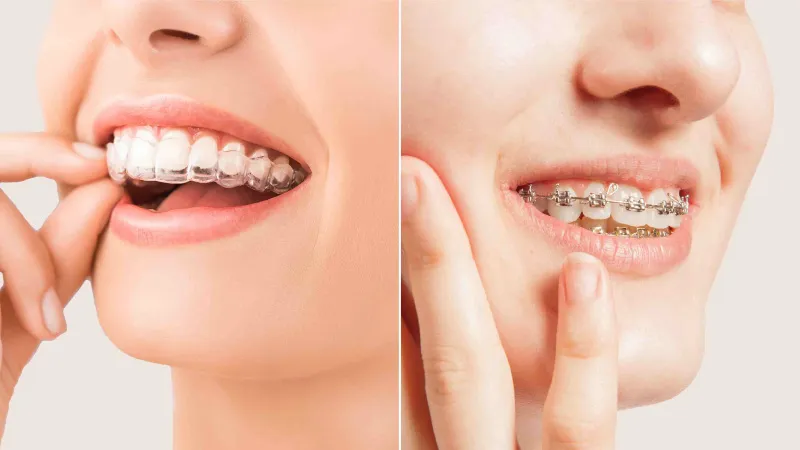
Traditional Braces
Orthodontic options for teeth alignment have expanded significantly over the years. While traditional braces were once the default choice, clear aligners have emerged as a popular alternative. Both approaches aim to correct misaligned teeth, improve oral function, and enhance appearance, but they come with distinct differences.
Aesthetics and Social Comfort
One of the most evident differences between aligners and traditional braces is their appearance. As the name suggests, clear aligners are made from transparent plastic, making them nearly invisible during wear. This subtle design appeals to individuals who prefer a less noticeable orthodontic option, particularly in professional or social settings.
On the other hand, traditional braces consist of metal brackets and wires attached to the teeth. Which makes them more visible. While modern braces offer variations like ceramic brackets that blend better with teeth, they remain more noticeable than aligners.
Convenience and Oral Hygiene
Clear aligners are designed to be removable, providing users with flexibility. They can be removed during meals, allowing you to eat without restrictions on food choices. Cleaning teeth is also easier with aligners because they are removed for brushing and flossing, enabling standard oral hygiene routines.
Traditional braces are fixed appliances, meaning they are bonded to the teeth for the entirety of the treatment. This requires additional care during meals to prevent food from getting stuck in the brackets or wires. Brushing and flossing can be more challenging, often necessitating special tools like interdental brushes.
Daily Wear Experience
Comfort can be a determining factor for many individuals. Clear aligners are generally known for being more comfortable due to their smooth plastic material, eliminating the risk of gums and cheeks irritation. They also apply gentle pressure to move the teeth into position, which can result in a less painful overall experience.
Traditional braces may cause discomfort, especially after adjustments. The metal wires and brackets can irritate the inside of the mouth, leading to soreness. Something else to think about is that broken brackets or wires may add to the inconvenience and require additional orthodontic visits for repairs.
Quick Results or Long-Term Solutions
While treatment duration depends on the case’s complexity, clear aligners often provide faster results for mild to moderate alignment issues. Treatment with aligners typically lasts 6 to 12 months, but this timeline can vary based on individual progress. Aligners might not always be suitable for severe or complex orthodontic concerns, which could sometimes limit their effectiveness.
Traditional braces, by comparison, are versatile and can address a broader range of dental issues. This includes severe alignment problems and bite corrections. Due to their versatility, braces may involve longer treatment durations ranging from 18 months to three years or more.
Financial Factors
Cost is another factor when deciding between these two options. Clear aligners are often more expensive than traditional braces. The price gap reflects the technology behind aligners, the materials used, and their aesthetic benefits. The number of aligners required throughout the treatment may influence overall costs.
While traditional braces are still a significant investment, they are generally more affordable. The final cost of either option will depend on the severity of the dental issue and the materials selected for braces or aligners. Insurance coverage and payment plans may also affect the financial feasibility of each choice.
Choosing What’s Right for You: Clear Aligners Vs. Braces
The decision between clear aligners and traditional braces depends on various factors, including your dental concerns, lifestyle preferences, and budget. Clear aligners offer subtlety, flexibility, and comfort, making them ideal for those seeking a less visible and convenient option. On the other hand, traditional braces can handle a wide range of orthodontic cases with higher effectiveness for complex issues. If you’re looking into either option, it’s best to consult an orthodontist who can thoroughly evaluate and recommend the most suitable treatment plan.
Discover the latest news and updates on The Blog Verge






